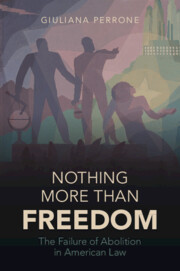Refine search
Actions for selected content:
45 results
9 - The Shrinking yet Still Formidable Powers of Congress
-
- Book:
- The Changing Constitution
- Published online:
- 21 August 2025
- Print publication:
- 21 August 2025, pp 239-267
-
- Chapter
- Export citation
7 - The Equal Protection of the Laws
-
- Book:
- The Changing Constitution
- Published online:
- 21 August 2025
- Print publication:
- 21 August 2025, pp 161-209
-
- Chapter
- Export citation
7 - The KCIR before the US Supreme Court
- from Part II - The KCIR in the World
-
- Book:
- The Kansas Court of Industrial Relations
- Published online:
- 26 July 2025
- Print publication:
- 14 August 2025, pp 178-196
-
- Chapter
- Export citation
3 - Race and Segregation
-
- Book:
- Race and the Law in the United States
- Published online:
- 19 May 2025
- Print publication:
- 05 June 2025, pp 88-128
-
- Chapter
- Export citation
3 - They Tried to Bury Us, but They Forgot We Were Seeds
-
- Book:
- Banned
- Published online:
- 19 December 2024
- Print publication:
- 02 January 2025, pp 30-45
-
- Chapter
- Export citation
14 - Victory and National Renaissance Amidst Backlash
-
- Book:
- Banned
- Published online:
- 19 December 2024
- Print publication:
- 02 January 2025, pp 228-244
-
- Chapter
- Export citation
8 - Guns and Fundamental Rights
- from Part II - Symmetry Applied
-
- Book:
- Constitutional Symmetry
- Published online:
- 14 November 2024
- Print publication:
- 21 November 2024, pp 203-222
-
- Chapter
- Export citation
7 - Equal Protection
- from Part II - Symmetry Applied
-
- Book:
- Constitutional Symmetry
- Published online:
- 14 November 2024
- Print publication:
- 21 November 2024, pp 179-202
-
- Chapter
- Export citation
Chapter 3 - 1860 or 1865? Amending the National Body
-
- Book:
- Disability, the Body, and Radical Intellectuals in the Literature of the Civil War and Reconstruction
- Published online:
- 13 June 2024
- Print publication:
- 04 July 2024, pp 103-133
-
- Chapter
- Export citation

Nothing More than Freedom
- The Failure of Abolition in American Law
-
- Published online:
- 04 May 2023
- Print publication:
- 11 May 2023
Pauli Murray: The US firebrand’s unique opportunity to influence a continent
-
- Journal:
- The Economic and Labour Relations Review / Volume 30 / Issue 4 / December 2019
- Published online by Cambridge University Press:
- 01 January 2023, pp. 566-579
-
- Article
- Export citation
3 - Commentary on Reynolds v. McNichols
-
-
- Book:
- Feminist Judgments: Health Law Rewritten
- Published online:
- 15 December 2022
- Print publication:
- 22 December 2022, pp 41-65
-
- Chapter
- Export citation
6 - Ricci v. DeStefano
-
- Book:
- Post-Racial Constitutionalism and the Roberts Court
- Published online:
- 27 October 2022
- Print publication:
- 03 November 2022, pp 143-162
-
- Chapter
- Export citation
2 - Enumerating Amendments
-
-
- Book:
- Amending America's Unwritten Constitution
- Published online:
- 13 October 2022
- Print publication:
- 20 October 2022, pp 57-72
-
- Chapter
- Export citation
Chapter 6 - Affiliated Races
- from Part II - Racial Citizenship
-
-
- Book:
- Race in American Literature and Culture
- Published online:
- 26 May 2022
- Print publication:
- 16 June 2022, pp 92-116
-
- Chapter
- Export citation
Stopping the Conversation about Isolation by Race and Poverty Before It Really Began: The Case of San Antonio Independent School District v. Rodriguez, 411 U.S. 1 (1973)
- from Part V - Justice
-
-
- Book:
- Critical Race Judgments
- Published online:
- 22 April 2022
- Print publication:
- 21 April 2022, pp 675-694
-
- Chapter
- Export citation
163 U.S. 537Supreme Court of the United States
- from Part I - Membership and Inclusion
-
- Book:
- Critical Race Judgments
- Published online:
- 22 April 2022
- Print publication:
- 21 April 2022, pp 85-103
-
- Chapter
- Export citation
410 U.S. 113Supreme Court of the United States
- from Part IV - Intimate Choice and Autonomy
-
- Book:
- Critical Race Judgments
- Published online:
- 22 April 2022
- Print publication:
- 21 April 2022, pp 523-534
-
- Chapter
- Export citation
347 U.S. 483 (1954)BROWN et al.
-
- Book:
- Critical Race Judgments
- Published online:
- 22 April 2022
- Print publication:
- 21 April 2022, pp 25-38
-
- Chapter
- Export citation
28 S. Ct. 324Supreme Court of the United States
- from Part V - Justice
-
- Book:
- Critical Race Judgments
- Published online:
- 22 April 2022
- Print publication:
- 21 April 2022, pp 651-662
-
- Chapter
- Export citation
